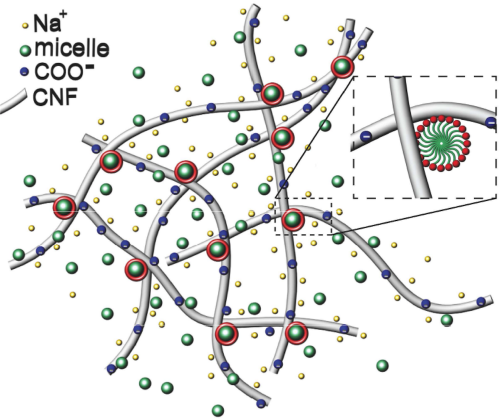
Nawal Quennouz and co-authors combine measurements from rheology and light scattering to demonstrate the importance of micellar-bridging of cellulose nanofibers (CNF) in determining both the micro-scopic and macro-scopic material properties of CNF suspensions. CNFs have impressive mechanical properties and an ability to form 3D percolated networks at low concentrations, and are highly sought after as a sustainable and biodegradable rheological modifier in a variety of complex fluid-based products. This study, from the Osuji lab, demonstrates a wide range of tunable material properties in CNF suspensions through the use of added surfactants, both ionic and non-ionic.
Rheology of cellulose nanofibrils in the presence of surfactants
Nawal Quennouz, Sara M. Hashmi, Hong Sung Choi, Jin Woong Kim, and Chinedum O. Osuji
Abstract:
Cellulose nanofibrils (CNFs) present unique opportunities for rheology modification in complex fluids. Here we systematically consider the effect of ionic and non-ionic surfactants on the rheology of dilute CNF suspensions. Neat suspensions are transparent yield-stress fluids which display strong shear thinning and power-law dependence of modulus on concentration, G’ ~ c2.1. Surfactant addition below a critical mass concentration cc produces an increase in the gel modulus with retention of optical clarity. Larger than critical concentrations induce significant fibril aggregation leading to the loss of suspension stability and optical clarity, and to aggregate sedimentation. The critical concentration was the lowest for a cationic surfactant (DTAB), cc ~ 0.08%, while suspension stability was retained for non-ionic surfactants (Pluronic F68, TX100) at concentrations up to 8%. The anionic surfactant SDS led to a loss of stability at cc ~ 1.6% whereas suspension stability was not compromised by anionic SLES up to 8%. Dynamic light scattering data are consistent with a scenario in which gel formation is driven by micelle–nanofibril bridging mediated by associative interactions of ethoxylated surfactant headgroups with the cellulose fibrils. This may explain the strong difference between the properties of SDS and SLES-modified suspensions. These results have implications for the use of CNFs as a rheology modifier in surfactant-containing systems.